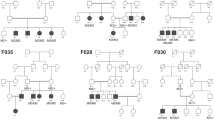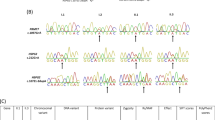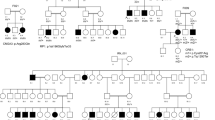Abstract
Non-specific intellectual disability of autosomal recessive inheritance (NS-ARID) represents an important fraction of severe cognitive dysfunction disorders. To date, only 10 genes have been identified, and further 24 linked-ARID loci have been reported, as well as others with suggestive linkage. To discover novel genes causing NS-ARID, we undertook genome-wide homozygosity mapping in 64 consanguineous multiplex families of Syrian descent. A total of 11 families revealed unique, significantly linked loci at 4q26-4q28 (MRT17), 6q12-q15 (MRT18), 18p11 (MRT19), 16p12-q12 (MRT20), 11p15 (MRT21), 11p13-q14 (MRT23), 6p12 (MRT24), 12q13-q15 (MRT25), 14q11-q12 (MRT26), 15q23-q26 (MRT27), and 6q26-q27 (MRT28), respectively. Loci ranged between 1.2 and 45.6 Mb in length. One family showed linkage to chromosome 8q24.3, and we identified a mutation in TRAPPC9. Our study further highlights the extreme heterogeneity of NS-ARID, and suggests that no major disease gene is to be expected, at least in this study group. Systematic analysis of large numbers of affected families, as presented here, will help discovering the genetic causes of ID.
Similar content being viewed by others
Log in or create a free account to read this content
Gain free access to this article, as well as selected content from this journal and more on nature.com
or
References
Ropers HH : Genetics of early onset cognitive impairment. Annu Rev Genomics Hum Genet 2010; 11: 161–187.
Rauch A, Hoyer J, Guth S et al: Diagnostic yield of various genetic approaches in patients with unexplained developmental delay or mental retardation. Am J Med Genet A 2006; 140: 2063–2074.
Ropers HH, Hamel BC : X-linked mental retardation. Nat Rev Genet 2005; 6: 46–57.
Bartley JA, Hall BD : Mental retardation and multiple congenital anomalies of unknown etiology: frequency of occurrence in similarly affected sibs of the proband. Birth Defects Orig Artic Ser 1978; 14: 127–137.
Priest JH, Thuline HC, Laveck GD, Jarvis DB : An approach to genetic factors in mental retardation. Studies of families containing at least two siblings admitted to a state institution for the retarded. Am J Ment Defic 1961; 66: 42–50.
Vissers LE, de Ligt J, Gilissen C et al: A de novo paradigm for mental retardation. Nat Genet 2010; 42: 1109–1112.
Najmabadi H, Motazacker MM, Garshasbi M et al: Homozygosity mapping in consanguineous families reveals extreme heterogeneity of non-syndromic autosomal recessive mental retardation and identifies 8 novel gene loci. Hum Genet 2007; 121: 43–48.
Rafiq MA, Ansar M, Marshall CR et al: Mapping of three novel loci for non-syndromic autosomal recessive mental retardation (NS-ARMR) in consanguineous families from Pakistan. Clin Genet 2010; 78: 478–483.
Uyguner O, Kayserili H, Li Y et al: A new locus for autosomal recessive non-syndromic mental retardation maps to 1p21.1-p13.3. Clin Genet 2007; 71: 212–219.
Kuss AW, Garshasbi M, Kahrizi K et al: Autosomal recessive mental retardation: homozygosity mapping identifies 27 single linkage intervals, at least 14 novel loci and several mutation hotspots. Hum Genet 2011; 129: 141–148.
Molinari F, Rio M, Meskenaite V et al: Truncating neurotrypsin mutation in autosomal recessive nonsyndromic mental retardation. Science 2002; 298: 1779–1781.
Higgins JJ, Pucilowska J, Lombardi RQ, Rooney JP : A mutation in a novel ATP-dependent Lon protease gene in a kindred with mild mental retardation. Neurology 2004; 63: 1927–1931.
Motazacker MM, Rost BR, Hucho T et al: A defect in the ionotropic glutamate receptor 6 gene (GRIK2) is associated with autosomal recessive mental retardation. Am J Hum Genet 2007; 81: 792–798.
Garshasbi M, Hadavi V, Habibi H et al: A defect in the TUSC3 gene is associated with autosomal recessive mental retardation. Am J Hum Genet 2008; 82: 1158–1164.
Molinari F, Foulquier F, Tarpey PS et al: Oligosaccharyltransferase-subunit mutations in nonsyndromic mental retardation. Am J Hum Genet 2008; 82: 1150–1157.
Mir A, Kaufman L, Noor A et al: Identification of mutations in TRAPPC9, which encodes the NIK- and IKK-beta-binding protein, in nonsyndromic autosomal-recessive mental retardation. Am J Hum Genet 2009; 85: 909–915.
Mochida GH, Mahajnah M, Hill AD et al: A truncating mutation of TRAPPC9 is associated with autosomal-recessive intellectual disability and postnatal microcephaly. Am J Hum Genet 2009; 85: 897–902.
Philippe O, Rio M, Carioux A et al: Combination of linkage mapping and microarray-expression analysis identifies NF-kappaB signaling defect as a cause of autosomal-recessive mental retardation. Am J Hum Genet 2009; 85: 903–908.
Caliskan M, Chong JX, Uricchio L et al: Exome sequencing reveals a novel mutation for autosomal recessive non-syndromic mental retardation in the TECR gene on chromosome 19p13. Hum Mol Genet 2011; 20: 1285–1289.
Zhang X, Snijders A, Segraves R et al: High-resolution mapping of genotype-phenotype relationships in cri du chat syndrome using array comparative genomic hybridization. Am J Hum Genet 2005; 76: 312–326.
Wang K, Li M, Hadley D et al: PennCNV: an integrated hidden Markov model designed for high-resolution copy number variation detection in whole-genome SNP genotyping data. Genome Res 2007; 17: 1665–1674.
O’Connell JR, Weeks DE : PedCheck: a program for identification of genotype incompatibilities in linkage analysis. Am J Hum Genet 1998; 63: 259–266.
Hoffmann K, Lindner TH : EasyLINKAGE-Plus--automated linkage analyses using large-scale SNP data. Bioinformatics 2005; 21: 3565–3567.
Lindner TH, Hoffmann K : EasyLINKAGE: a PERL script for easy and automated two-/multi-point linkage analyses. Bioinformatics 2005; 21: 405–407.
Seelow D, Schuelke M, Hildebrandt F, Nurnberg P : HomozygosityMapper--an interactive approach to homozygosity mapping. Nucleic Acids Res 2009; 37: W593–W599.
Kruglyak L, Daly MJ, Reeve-Daly MP, Lander ES : Parametric and nonparametric linkage analysis: a unified multipoint approach. Am J Hum Genet 1996; 58: 1347–1363.
Gudbjartsson DF, Thorvaldsson T, Kong A, Gunnarsson G, Ingolfsdottir A : Allegro version 2. Nat Genet 2005; 37: 1015–1016.
Shahin H, Walsh T, Rayyan AA et al: Five novel loci for inherited hearing loss mapped by SNP-based homozygosity profiles in Palestinian families. Eur J Hum Genet 2010; 18: 407–413.
Wetmore DZ, Garner CC : Emerging pharmacotherapies for neurodevelopmental disorders. J Dev Behav Pediatr 2010; 31: 564–581.
Acknowledgements
We thank the patients and their families for their cooperation. We also thank Angelika Diem, Nadine Kluck, and Petra Rothe for the excellent technical support. We thank Dr Cornelia Kraus for the diagnostics of Fra X syndrome and X-inactivation. R Abou Jamra was supported by the Deutsche Forschungsgemeinschaft (DFG) (grant AB393/1-1 and 1-2). This study was supported by the German Intellectual disability Network (MRNET) through a grant from the German Ministry of Research and Education to A Reis (01GS08160).
Author information
Authors and Affiliations
Corresponding author
Ethics declarations
Competing interests
The authors declare no conflict of interest.
Additional information
Supplementary Information accompanies the paper on European Journal of Human Genetics website
Supplementary information
Rights and permissions
About this article
Cite this article
Abou Jamra, R., Wohlfart, S., Zweier, M. et al. Homozygosity mapping in 64 Syrian consanguineous families with non-specific intellectual disability reveals 11 novel loci and high heterogeneity. Eur J Hum Genet 19, 1161–1166 (2011). https://doi.org/10.1038/ejhg.2011.98
Received:
Revised:
Accepted:
Published:
Issue date:
DOI: https://doi.org/10.1038/ejhg.2011.98
Keywords
This article is cited by
-
A cohort study of neurodevelopmental disorders and/or congenital anomalies using high resolution chromosomal microarrays in southern Brazil highlighting the significance of ASD
Scientific Reports (2024)
-
Biallelic loss of TRAPPC9 function links vesicle trafficking pathway to autosomal recessive intellectual disability
Journal of Human Genetics (2022)
-
Mapping the Diverse Genetic Disorders and Rare Diseases Among the Syrian Population: Implications on Refugee Health and Health Services in Host Countries
Journal of Immigrant and Minority Health (2020)
-
The role of CNVs in the etiology of rare autosomal recessive disorders: the example of TRAPPC9-associated intellectual disability
European Journal of Human Genetics (2018)
-
Genetics of autosomal recessive intellectual disability
Medizinische Genetik (2018)



